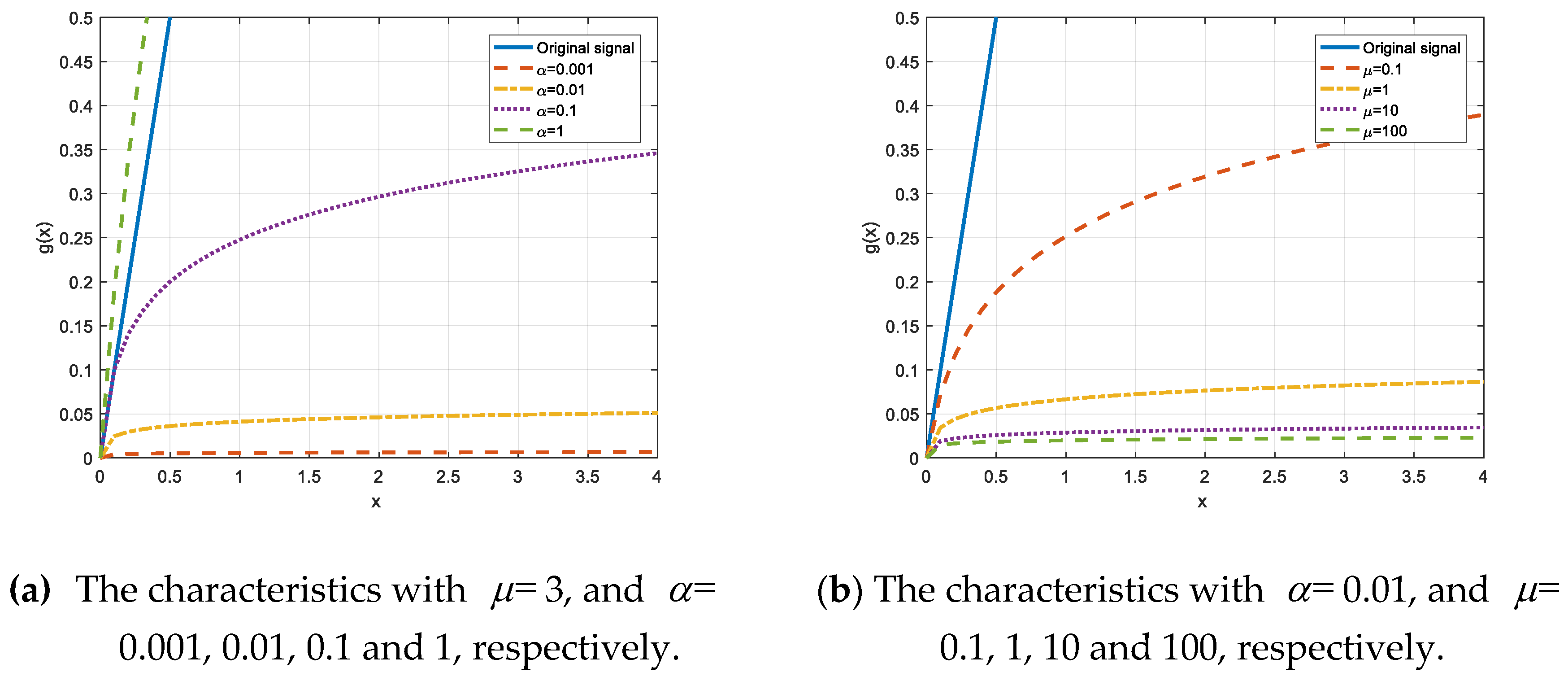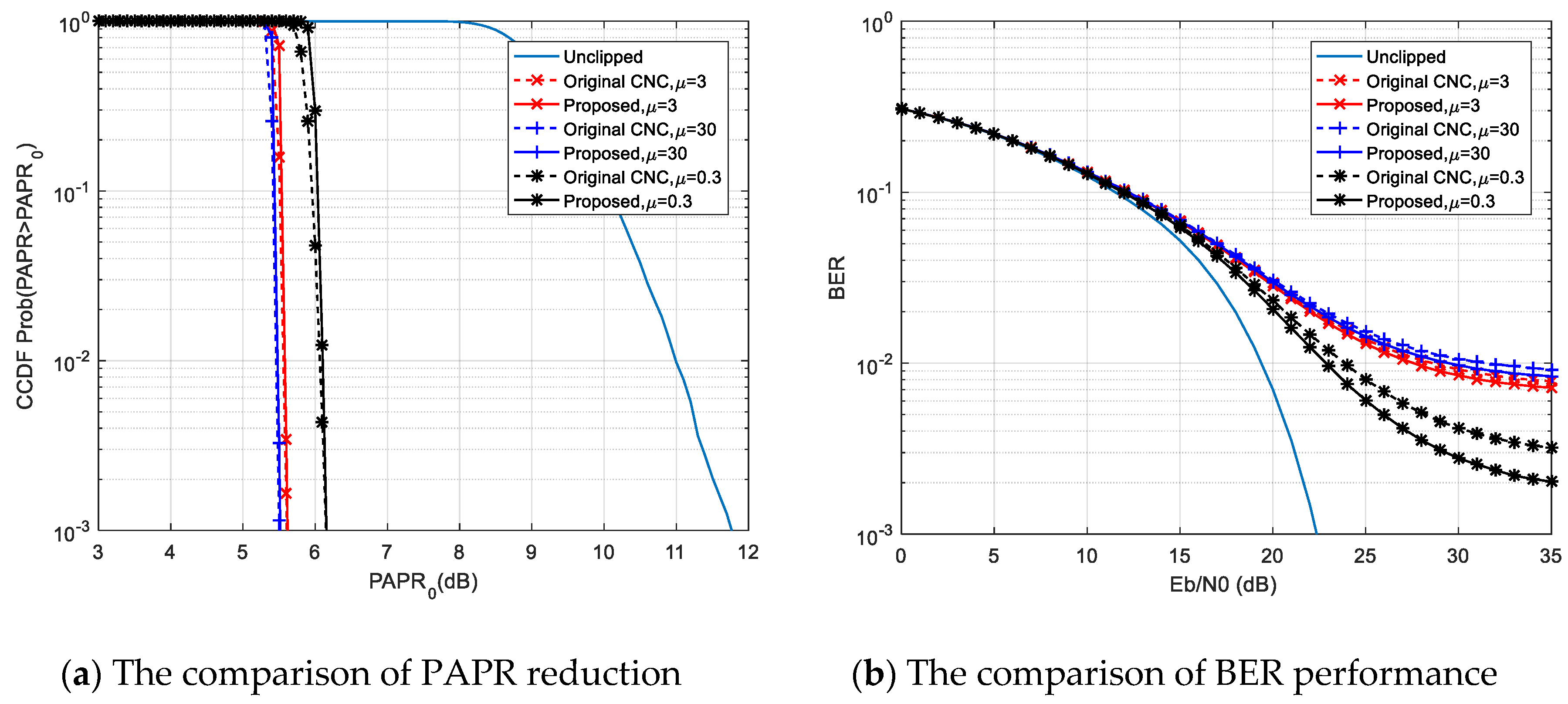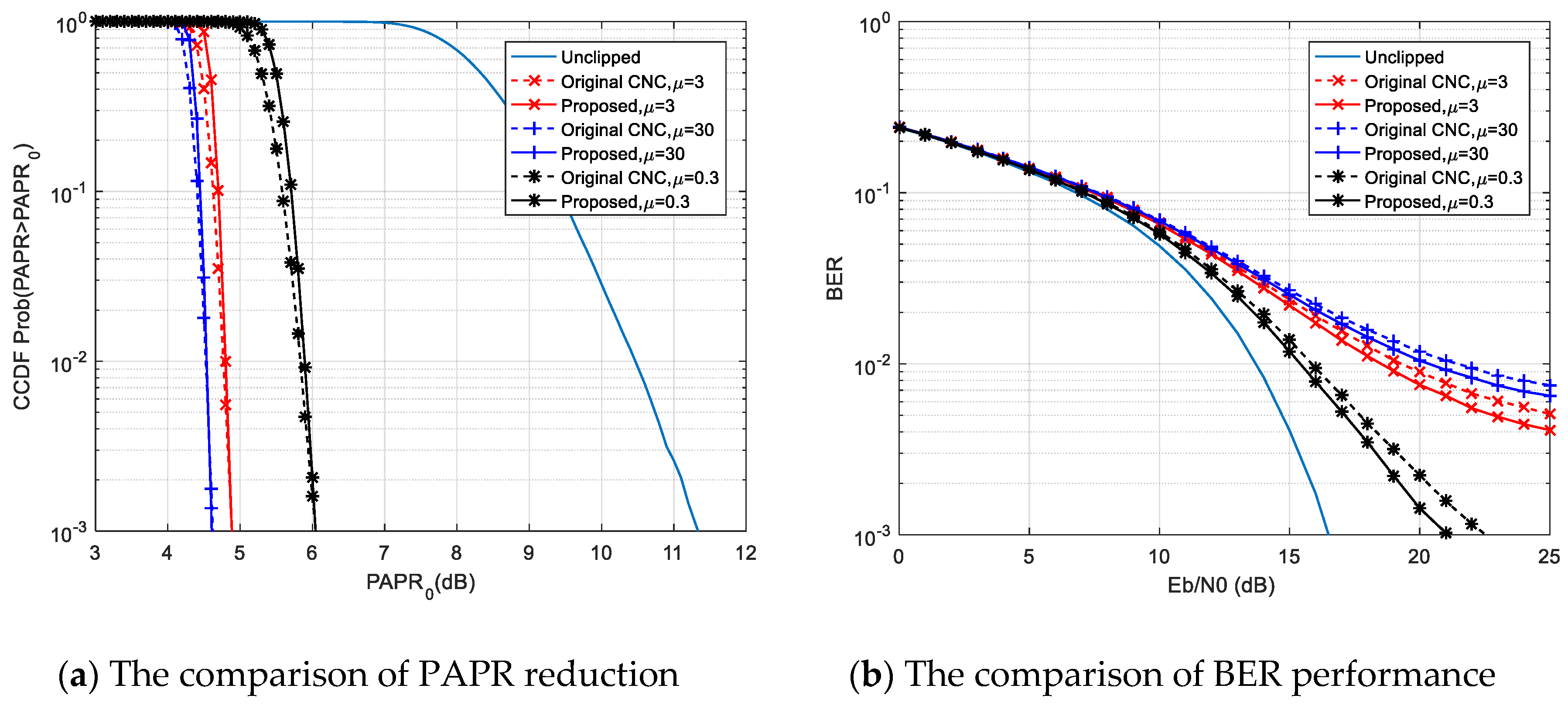A Novel Clipping-Based Method to Reduce Peak-To-Average Power Ratio of OFDM Signals
Abstract
1. Introduction
2. System Model
3. Description and Analysis of the Proposed Method
3.1. Description of Original CNC
3.2. The Proposed Method
- (1)
- Use IFFT to transform the OFDM symbol to the time domain to obtain .
- (2)
- According to the preset clipping ratio and the average power , calculate the clipping threshold as shown in (7).
- (3)
- Clip the amplitude of according to (8) to get the clipped signal , then calculate the clipping noise according to (9).
- (4)
- Compress the amplitude of to get the compressed noise according to (13).
- (5)
- Modify the clipped OFDM signal according to (11) to get the transmission signal .
3.3. Analysis of the Proposed Method
4. Simulation Results and Discussion
4.1. Simulation Results
4.2. Discussion
5. Conclusions
Author Contributions
Funding
Conflicts of Interest
References
- Feng, D.Q.; Jiang, C.Z.; Lim, G.; Cimini, L.J.; Feng, G.; Li, G.Y. A Survey of Energy-Efficient Wireless Communications. IEEE Commun. Surv. Tutor. 2013, 15, 167–178. [Google Scholar] [CrossRef]
- Hwang, T.; Yang, C.Y.; Wu, G.; Li, S.Q.; Li, G.Y. OFDM and Its Wireless Applications: A Survey. IEEE Trans. Veh. Technol. 2009, 58, 1673–1694. [Google Scholar] [CrossRef]
- Eizmendi, I.; Velez, M.; Gomez-Barquero, D.; Morgade, J.; Baena-Lecuyer, V.; Slimani, M.; Zoellner, J. DVB-T2: The Second Generation of Terrestrial Digital Video Broadcasting System. IEEE Trans. Broadcast. 2014, 60, 258–271. [Google Scholar] [CrossRef]
- Khorov, E.; Kiryanov, A.; Lyakhov, A.; Bianchi, G. A Tutorial on IEEE 802.11 ax High Efficiency WLANs. IEEE Commun. Surv. Tutor. 2019, 21, 197–216. [Google Scholar] [CrossRef]
- Lien, S.Y.; Shieh, S.L.; Huang, Y.M.; Su, B.C.; Hsu, Y.L.; Wei, H.Y. 5G New Radio: Waveform, Frame Structure, Multiple Access, and Initial Access. IEEE Commun. Mag. 2017, 55, 64–71. [Google Scholar] [CrossRef]
- Wunder, G.; Fischer, R.F.H.; Boche, H.; Litsyn, S.; No, J.S. The PAPR Problem in OFDM Transmission. IEEE Signal Process. Mag. 2013, 30, 130–144. [Google Scholar] [CrossRef]
- Lavrador, P.M.; Cunha, T.R.; Cabral, P.M.; Pedro, J.C. The Linearity-Efficiency Compromise. IEEE Microw. Mag. 2010, 11, 44–58. [Google Scholar] [CrossRef]
- Joung, J.G.; Ho, C.K.; Adachi, K.; Sun, S.M. A Survey on Power-Amplifier-Centric Techniques for Spectrum- and Energy-Efficient Wireless Communications. IEEE Commun. Surv. Tutor. 2015, 17, 315–333. [Google Scholar] [CrossRef]
- Jiang, T.; Wu, Y. An overview: Peak-to-Average Power Ratio reduction techniques for OFDM signals. IEEE Trans. Broadcast. 2008, 54, 257–268. [Google Scholar] [CrossRef]
- Lim, D.W.; Heo, S.J.; No, J.S. An Overview of Peak-to-Average Power Ratio Reduction Schemes for OFDM Signals. J. Commun. Netw. 2009, 11, 229–239. [Google Scholar] [CrossRef]
- Rahmatallah, Y.; Mohan, S. Peak-To-Average Power Ratio Reduction in OFDM Systems: A Survey and Taxonomy. IEEE Commun. Surv. Tutor. 2013, 15, 1567–1592. [Google Scholar] [CrossRef]
- Sandoval, F.; Poitau, G.; Gagnon, F. Hybrid Peak-to-Average Power Ratio Reduction Techniques: Review and Performance Comparison. IEEE Access 2017, 5, 27145–27161. [Google Scholar] [CrossRef]
- Liu, X.R.; Zhang, X.Y.; Xiong, J.; Gu, F.L.; Wei, J.B. An Enhanced Iterative Clipping and Filtering Method Using Time-Domain Kernel Matrix for PAPR Reduction in OFDM Systems. IEEE Access 2019, 7, 59466–59476. [Google Scholar] [CrossRef]
- Xia, Y.; Ji, J. Low-Complexity Blind Selected Mapping Scheme for Peak-to-Average Power Ratio Reduction in Orthogonal Frequency-Division Multiplexing Systems. Information 2018, 9, 220. [Google Scholar] [CrossRef]
- Li, C.P.; Wang, S.H.; Wang, C.L. Novel Low-Complexity SLM Schemes for PAPR Reduction in OFDM Systems. IEEE Trans. Signal Process. 2010, 58, 2916–2921. [Google Scholar]
- Jawhar, Y.A.; Audah, L.; Taher, M.A.; Ramli, K.N.; Shah, N.S.M.; Musa, M.; Ahmed, M.S. A Review of Partial Transmit Sequence for PAPR Reduction in the OFDM Systems. IEEE Access 2019, 7, 18021–18041. [Google Scholar] [CrossRef]
- Anoh, K.; Tanriover, C.; Adebisi, B.; Hammoudeh, M. A New Approach to Iterative Clipping and Filtering PAPR Reduction Scheme for OFDM Systems. IEEE Access 2018, 6, 17533–17544. [Google Scholar] [CrossRef]
- Miao, P.; Chen, P.; Chen, Z.M. Low-Complexity PAPR Reduction Scheme Combining Multi-Band Hadamard Precoding and Clipping in OFDM-Based Optical Communications. Electronics 2018, 7, 16. [Google Scholar] [CrossRef]
- Ali, N.; Almahainy, R.; Al-Shabili, A.; Almoosa, N.; Abd-Alhameed, R. Analysis of Improved mu-Law Companding Technique for OFDM Systems. IEEE Trans. Consum. Electron. 2017, 63, 126–134. [Google Scholar] [CrossRef]
- Armstrong, J. Peak-to-average power reduction for OFDM by repeated clipping and frequency domain filtering. Electron. Lett. 2002, 38, 246–247. [Google Scholar] [CrossRef]
- Wang, L.Q.; Tellambura, C. A simplified clipping and filtering technique for PAR reduction in OFDM systems. IEEE Signal. Process. Lett. 2005, 12, 453–456. [Google Scholar] [CrossRef]
- Tang, B.; Qin, K.Y.; Zhang, X.Y.; Chen, C.W. A Clipping-Noise Compression Method to Reduce PAPR of OFDM Signals. IEEE Commun. Lett. 2019, 23, 1389–1392. [Google Scholar] [CrossRef]
- Adebisi, B.; Anoh, K.; Rabie, K.M. Enhanced Nonlinear Companding Scheme for Reducing PAPR of OFDM Systems. IEEE Syst. J. 2019, 13, 65–75. [Google Scholar] [CrossRef]
- Ochiai, H.; Imai, H. On the distribution of the peak-to-average power ratio in OFDM signals. IEEE Trans. Commun. 2001, 49, 282–289. [Google Scholar] [CrossRef]
- Behravan, A.; Eriksson, T. Some Statistical Properties of Multicarrier Signals and Related Measures. In Proceedings of the 2006 IEEE 63rd Vehicular Technology Conference, New York, NY, USA, 7–10 March 2006; Volumes 1–6, pp. 1854–1858. [Google Scholar]







© 2020 by the authors. Licensee MDPI, Basel, Switzerland. This article is an open access article distributed under the terms and conditions of the Creative Commons Attribution (CC BY) license (http://creativecommons.org/licenses/by/4.0/).
Share and Cite
Tang, B.; Qin, K.; Chen, C.; Cao, Y. A Novel Clipping-Based Method to Reduce Peak-To-Average Power Ratio of OFDM Signals. Information 2020, 11, 113. https://doi.org/10.3390/info11020113
Tang B, Qin K, Chen C, Cao Y. A Novel Clipping-Based Method to Reduce Peak-To-Average Power Ratio of OFDM Signals. Information. 2020; 11(2):113. https://doi.org/10.3390/info11020113
Chicago/Turabian StyleTang, Bo, Kaiyu Qin, Changwei Chen, and Yong Cao. 2020. "A Novel Clipping-Based Method to Reduce Peak-To-Average Power Ratio of OFDM Signals" Information 11, no. 2: 113. https://doi.org/10.3390/info11020113
APA StyleTang, B., Qin, K., Chen, C., & Cao, Y. (2020). A Novel Clipping-Based Method to Reduce Peak-To-Average Power Ratio of OFDM Signals. Information, 11(2), 113. https://doi.org/10.3390/info11020113




